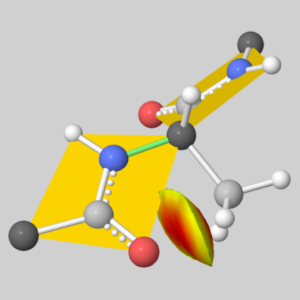Proteopedia:Featured EDU/1
From Proteopedia
(Difference between revisions)
| Line 5: | Line 5: | ||
The Ramachandran Principle says that alpha helices, beta strands, and turns are the most likely conformations for a polypeptide chain to adopt, because most other conformations are impossible due to steric collisions between atoms. | The Ramachandran Principle says that alpha helices, beta strands, and turns are the most likely conformations for a polypeptide chain to adopt, because most other conformations are impossible due to steric collisions between atoms. | ||
Check Show Clashes to see where non-bonded atoms are overlapping, and thus in physically impossible positions. | Check Show Clashes to see where non-bonded atoms are overlapping, and thus in physically impossible positions. | ||
| + | |||
| + | >>> [[Tutorial:Ramachandran_principle_and_phi_psi_angles|Visit this tutorial]] >>> | ||
</div> | </div> | ||
</td></tr> | </td></tr> | ||
</table> | </table> | ||
| - | |||
| - | >>> [[Tutorial:Ramachandran_principle_and_phi_psi_angles|Visit this tutorial]] >>> | ||
[[Category:Featured in Education]] | [[Category:Featured in Education]] | ||
Revision as of 13:11, 18 October 2018
Tutorial: The Ramachandran principle, phi (φ) and psi (ψ) angles in proteins
by Eric Martz >>> Visit this tutorial >>> |

